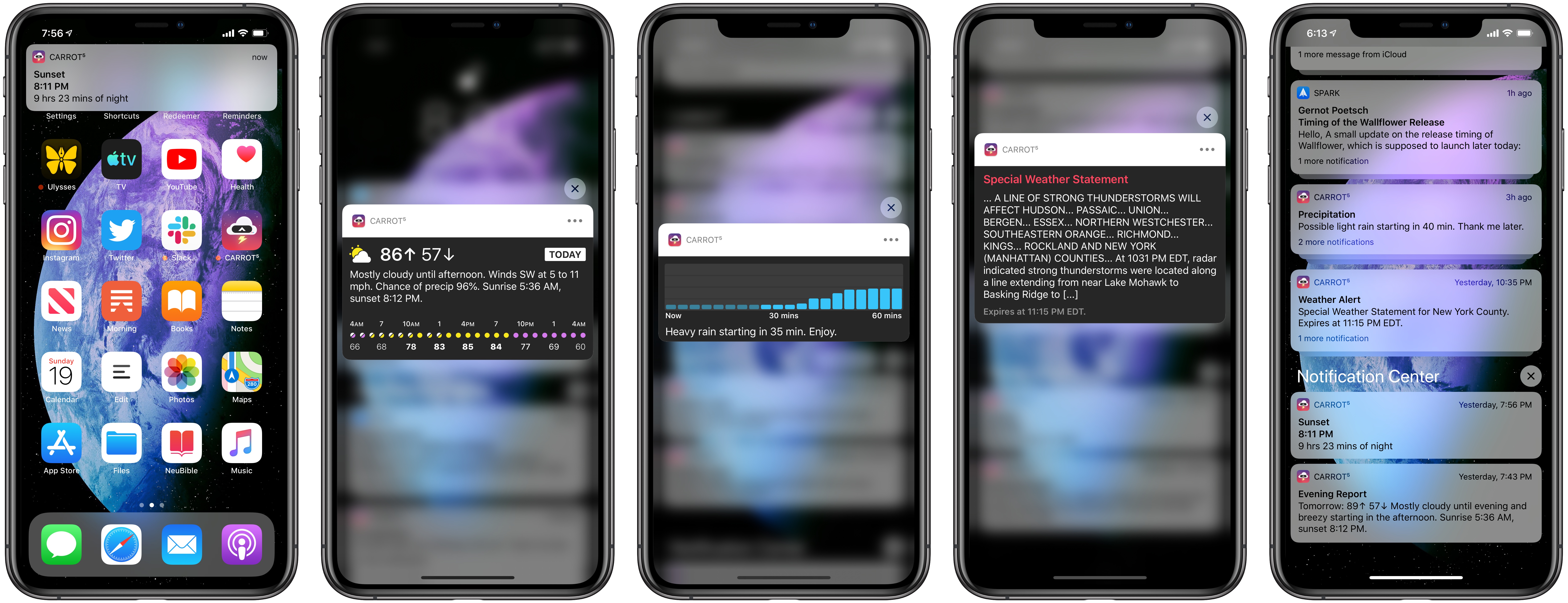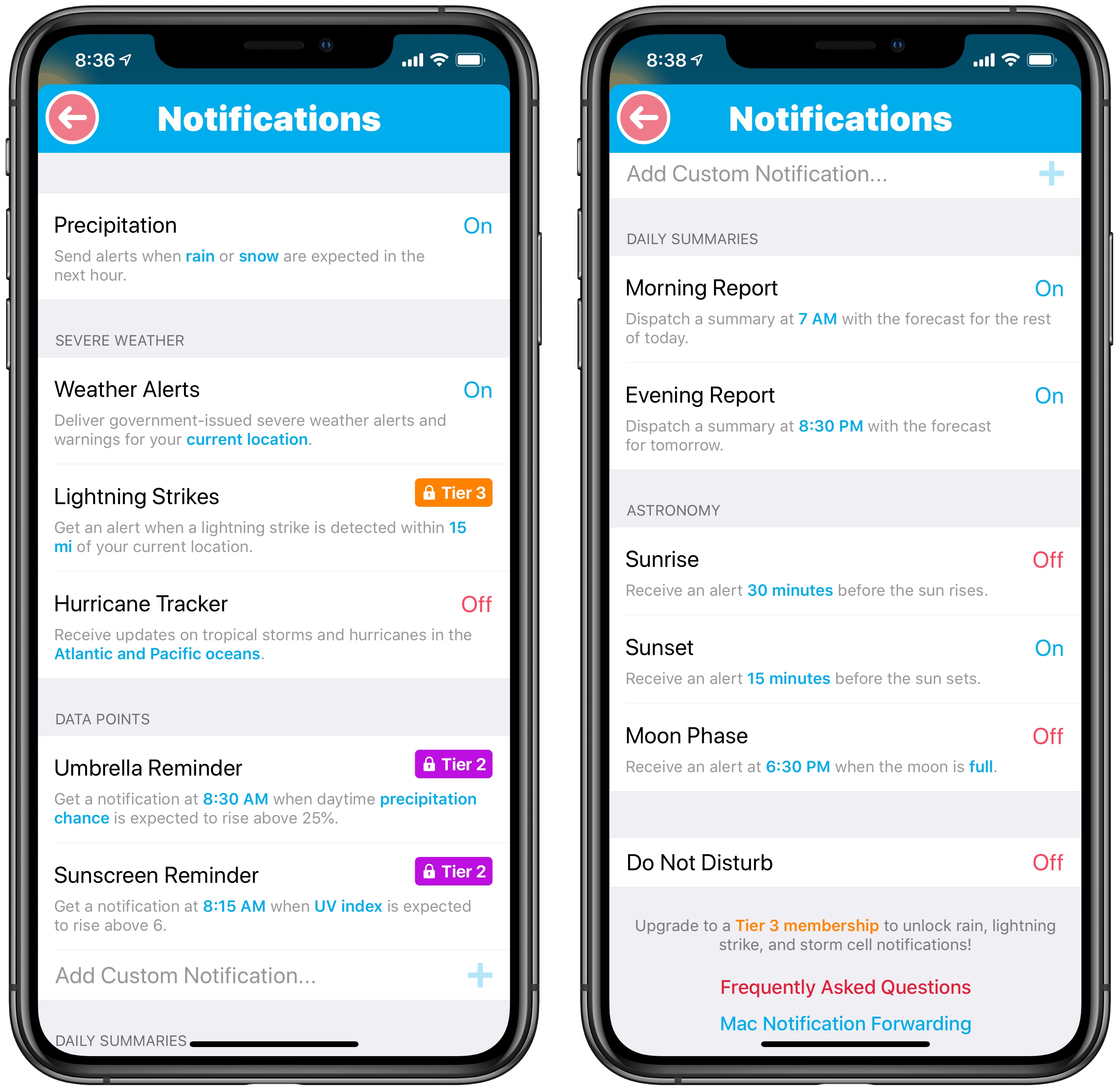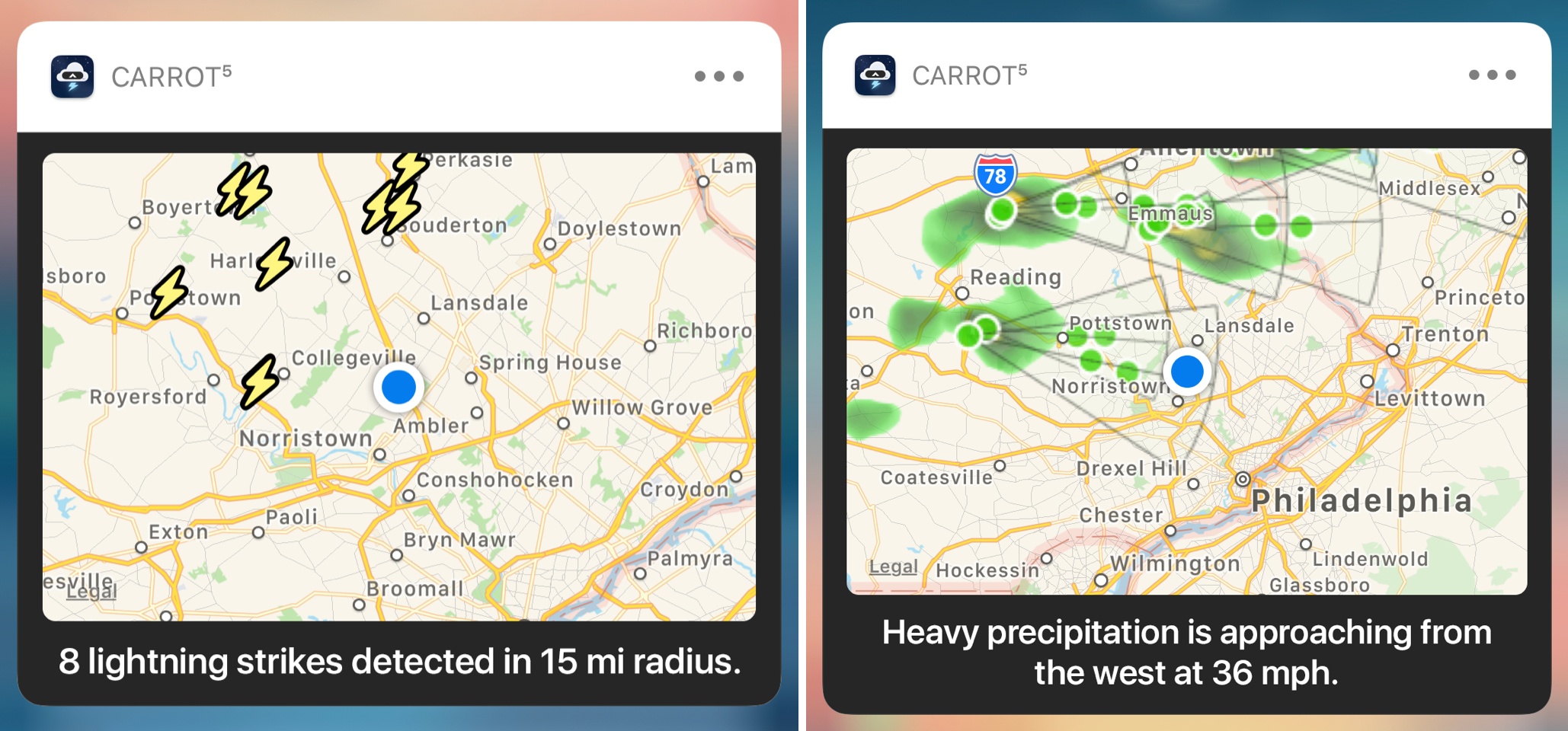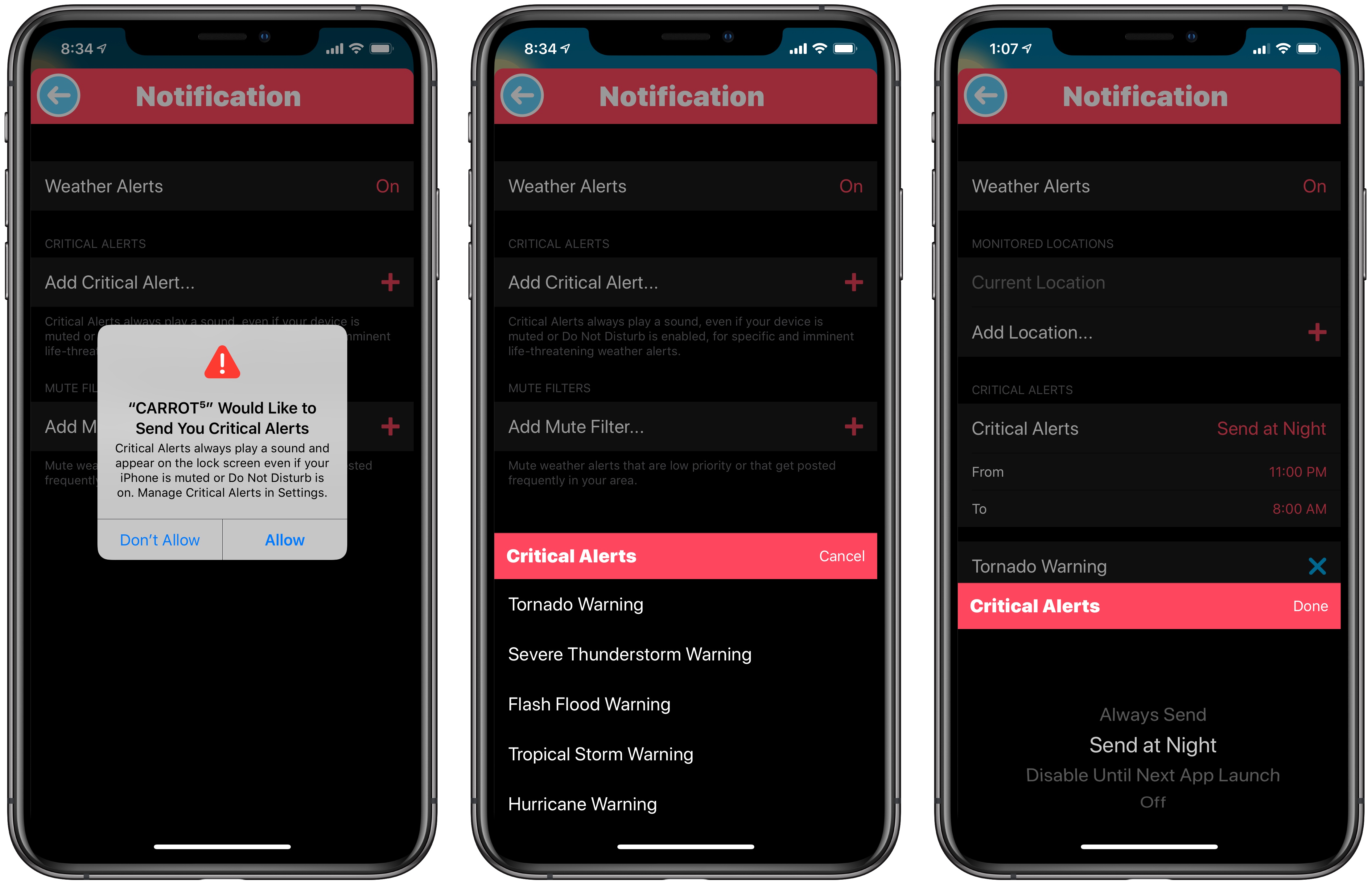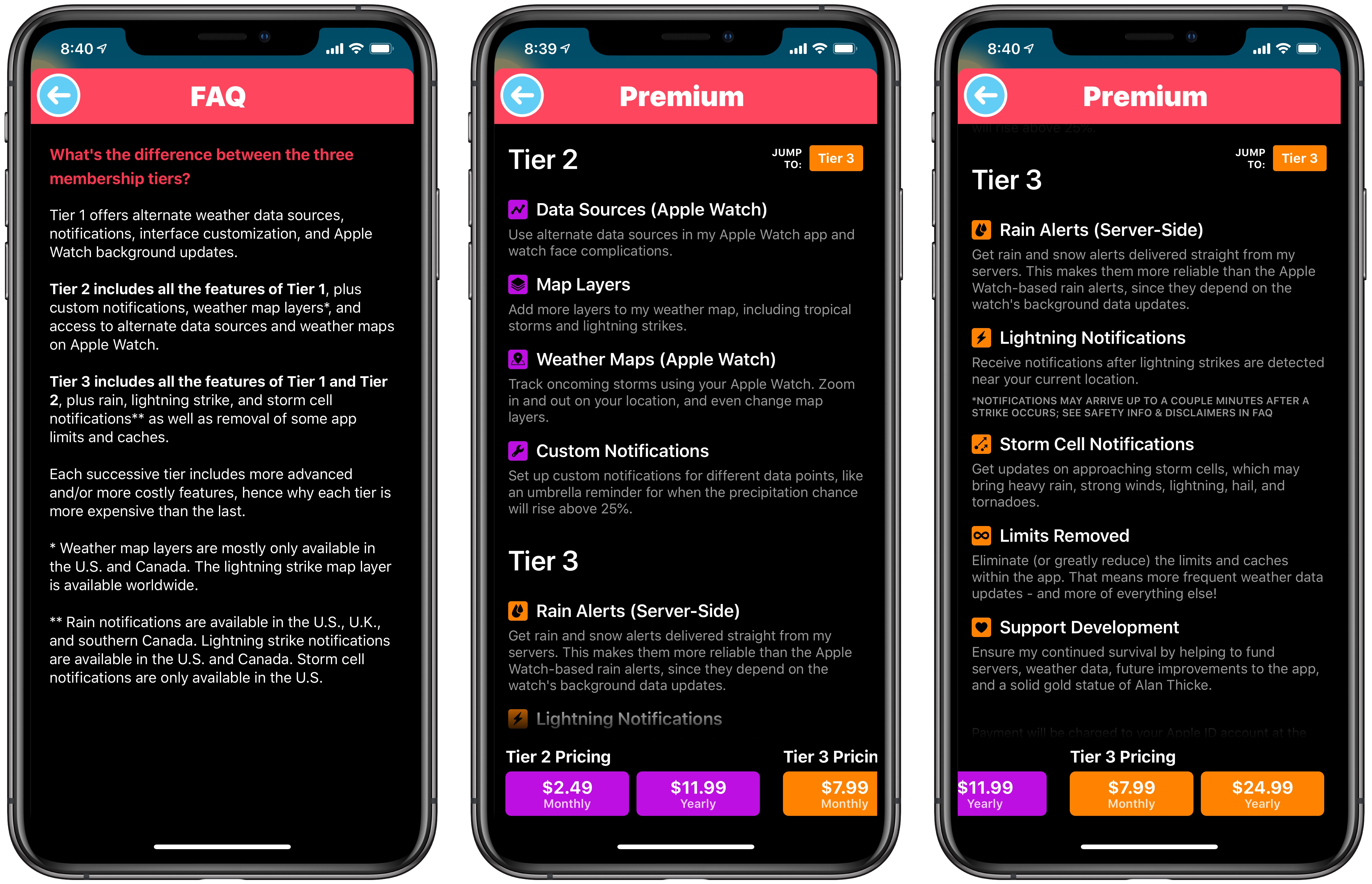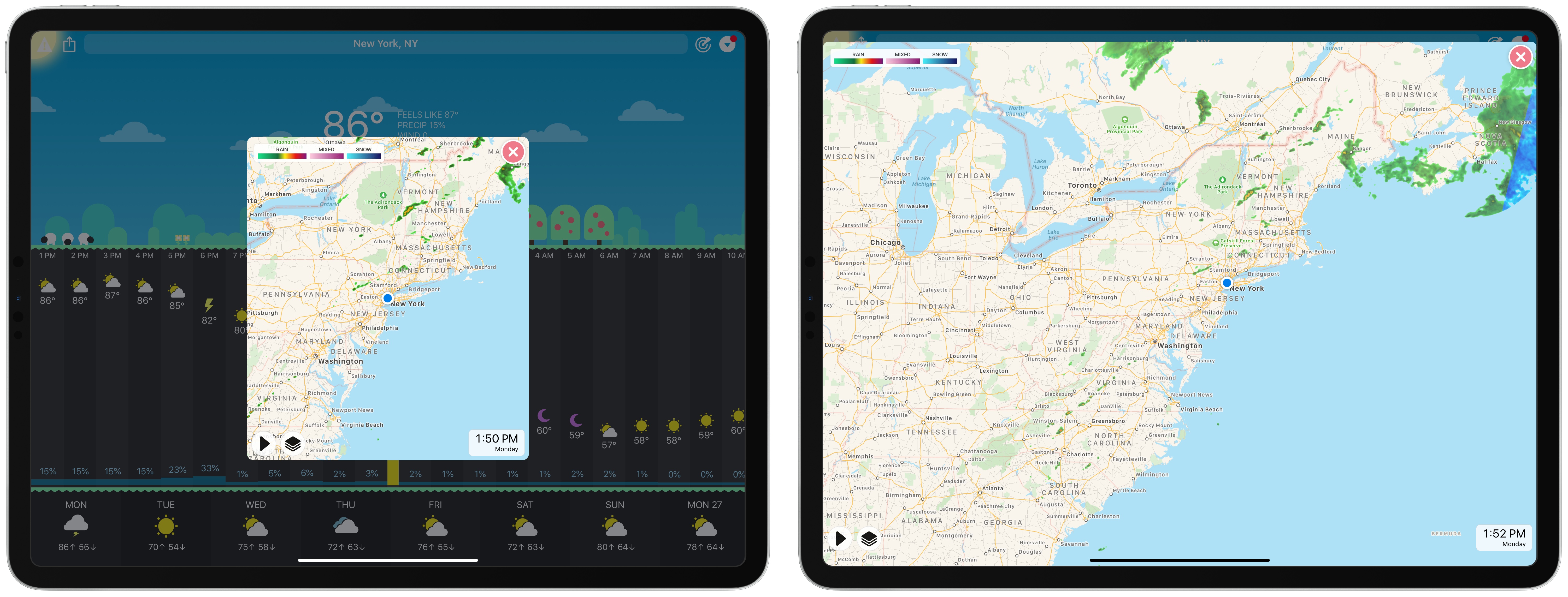The latest update to CARROT Weather was released today, version 4.11, which is centered entirely around notifications. Though the types of notifications available depend on your subscription plan due to the different costs associated with each data source, in total there are a ton of options available to satisfy anyone’s needs. Whether you simply want to avoid getting caught in the rain without an umbrella, or finding yourself outdoors when a storm hits, or one of many other weather situations, CARROT Weather can now keep you informed with timely notifications for a variety of weather events.
Notifications
CARROT Weather offered a handful of notification options in previous versions, and its rich notifications have long been a strong platform example – in other words, the app was no notification slouch before. Today’s update, however, takes all of the previous power and flexibility of notifications and puts it on steroids.
Storm cells and lightning strikes are two of the brand new domains that CARROT can track and send notifications for.1 The former relies on your location to notify you when storm cells are approaching your area, so you can quickly get to shelter, move the cars into the garage, or anything else on your pre-storm checklist. Lightning notifications can be sent as often as once per minute, but if you don’t want or need to be notified that often during a severe thunderstorm, you can manually adjust the interval between notifications.
Precipitation notifications were previously only available to users of the Apple Watch or Mac apps, but now they’re being extended to the iOS app alone because they’re being served directly from CARROT’s servers. This change should make the notifications more reliable than ever, but it does require a more costly subscription plan; Watch or Mac-based notifications are still available to subscribers of lower-tiered plans, however.
Custom notifications enable configuring different data points that serve as thresholds for delivering a notification. You can, for example, get a morning reminder when the UV index for the day merits bringing sunscreen, or the chance of rain means you’ll want an umbrella on-hand. The power here is in custom notifications’ flexibility: you can choose exactly what threshold merits receiving a rain notification, whether it’s 20%, 40%, or anything you desire.
Government-issued weather alerts can now be delivered via notification too. Where this is especially interesting is that CARROT Weather uses a new iOS 12 technology called Critical Alerts to optionally ensure that key alerts are received whether your device is silenced or in Do Not Disturb mode. Federico detailed this special notification type in his iOS 12 review:
Designed for apps that deliver urgent and critical information, these special notifications are highly disruptive in that they always play a sound (which can be a custom one at an app-specified level), bypass Do Not Disturb, and always ignore the ringer switch. Critical alerts can be local or push notifications, and they play whether the device is unlocked or not. Moreover, critical alerts carry a special red exclamation point next to their title and have their own dedicated section in the Settings app.
Due to how invasive a critical alert is, I appreciate the way CARROT has implemented the feature: you can get any or all government weather alerts as standard notifications, rather than critical alerts if you choose, and if you do want to use critical alerts, the app lets you manually configure exactly which types of weather events to activate them for. They can be enabled for tornado warnings, severe thunderstorm warnings, flash flood warnings, tropical storm warnings, and hurricane warnings. Beyond even the flexibility of choosing which weather events merit a critical alert, CARROT goes further by offering the ability for each alert to only be sent at night, during the hours you specify, or you can have them sent regardless of time of day. These additional options are truly thoughtful and make the feature something that can be taken advantage of without fearing unnecessary interruptions.
Finally in the realm of new notification types, you can now configure notifications regarding the time of sunrise or sunset, or moon phase. Also, the existing feature to receive morning and evening reports can be set for delivery at any time of day you choose, not the restricted set of options previously available.
It’s also worth noting, as a final detail related to notification improvements, that CARROT Weather includes its own Do Not Disturb mode, so even if you don’t use the system-wide Do Not Disturb on iOS, you can manually enable or disable CARROT notifications at certain times of day. The only notifications that ignore this setting are critical alerts, and those with a delivery time you manually established.
Miscellany
Subscription revisions. Due to the extra costs associated with many of the new notification features, CARROT Weather has added a new high-end subscription option to enable certain notifications. And to reduce confusion, the former Premium and Ultrapremium plans have been renamed to simply Tier 1 and Tier 2, with the new plan named Tier 3. Nothing has changed about the previous plans, other than the addition of some new features, they’ve simply been renamed to make room for a third plan.
Dark mode improvements. I always use CARROT Weather in dark mode, and before today’s update that was a mixed experience. I didn’t care for how menus looked in dark mode, but my main reason for leaving it activated was the app’s loading screen when you launch it: dark mode’s black background for the screen looks great on OLED iPhones. However, even the loading screen wasn’t the best experience before, as it would always display an all-white screen for a split second before switching to the appropriate black one. Fortunately, today’s update resolves that issue so dark mode users aren’t blinded by the first flash of the loading screen, and additionally several other elements of the app have freshly implemented dark features, including the menus, which look much better than before.
Full-screen maps on iPad. As shown below, weather maps on the iPad used to be constrained to a small portion of the screen. Now, they display in full-screen glory.
Edit saved location names. If you’d like to set a custom name for each of your saved locations in CARROT Weather that’s now possible. The custom name will display prominently while the precise location will still appear in smaller text beneath it.
Haptics. Haptic feedback has been added to several aspects of the app, which I love. For anyone not a fan of haptics, you can disable them from the Personality section in CARROT’s settings.
CARROT Weather is one of the few apps I would describe as having a delightful interface. Whether due to its playful design, witty personality, or both, I regularly interact with CARROT by opening the full app rather than relying on, say, a widget, like I historically have for other weather apps. However, today’s update drastically reduces my need to ever open the full app. Now that practically any weather data you want can be delivered via notification, once you set up the appropriate notifications to your liking, you’ll find yourself opening CARROT less often. And that’s okay. A weather app doesn’t need to be a utility that’s regularly opened; instead, it’s the perfect candidate for taking advantage of extensibility on iOS. And that’s exactly what CARROT Weather does in this release: extends itself in more ways that make it more useful to a broader base of users.
CARROT Weather is available on the App Store.
- Both storm cell and lightning strike notifications are US-only. ↩︎


